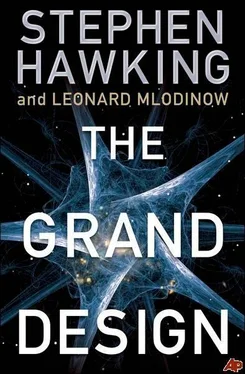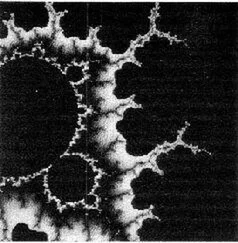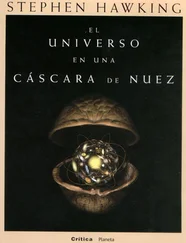There is no reason to believe that the speed parameter in Maxwell’s equations is a speed measured relative to the earth. His equations, after all, apply to the entire universe. An alternative answer that was considered for a while is that his equations specify the speed of light relative to a previously undetected medium permeating all space, called the luminiferous ether, or for short, simply the ether, which was Aristotle’s term for the substance he believed filled all of the universe outside the terrestrial sphere. This hypothetical ether would be the medium through which electromagnetic waves propagate, just as sound propagates through air. If the ether existed, there would be an absolute standard of rest (that is, rest with respect to the ether) and hence an absolute way of defining motion as well. The ether would provide a preferred frame of reference throughout the entire universe, against which any object’s speed could be measured. So the ether was postulated to exist on theoretical grounds, setting some scientists off on a search for a way to study it, or at least to confirm its existence. One of those scientists was Maxwell himself.
If you race through the air toward a sound wave, the wave approaches you faster, and if you race away, it approaches you more slowly. Similarly, if there were an ether, the speed of light would vary depending on your motion relative to the ether. In fact, if light worked the way sound does, just as people on a supersonic jet will never hear any sound that emanates from behind the plane, so too would travelers racing quickly enough through the ether be able to outrun a light wave. Working from such considerations, Maxwell suggested an experiment. If there is an ether, the earth must be moving through it as it orbits the sun. And since the earth is traveling in a different direction in January than, say, in April or July, one ought to be able to observe a tiny difference in the speed of light at different times of the year-see the figure below.
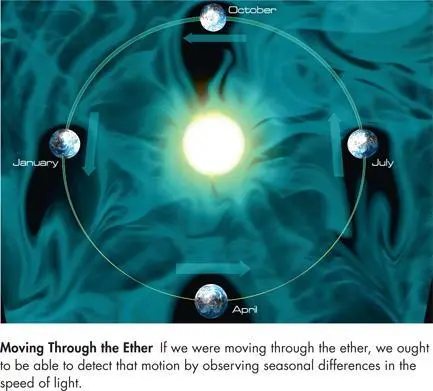
Maxwell was talked out of publishing his idea in Proceedings of the Royal Society by its editor, who didn’t think the experiment would work. But in 1879, shortly before he died at age forty-eight of painful stomach cancer, Maxwell sent a letter on the subject to a friend. The letter was published posthumously in the journal Nature, where it was read by, among others, an American physicist named Albert Michelson. Inspired by Maxwell’s speculation, in 1887 Michelson and Edward Morley carried out a very sensitive experiment designed to measure the speed at which the earth travels through the ether. Their idea was to compare the speed of light in two different directions, at right angles. If the speed of light were a fixed number relative to the ether, the measurements should have revealed light speeds that differed depending on the direction of the beam. But Michelson and Morley observed no such difference.
The outcome of the Michelson and Morley experiment is clearly in conflict with the model of electromagnetic waves traveling through an ether, and should have caused the ether model to be abandoned. But Michelson’s purpose had been to measure the speed of the earth relative to the ether, not to prove or disprove the ether hypothesis, and what he found did not lead him to conclude that the ether didn’t exist. No one else drew that conclusion either. In fact, the famous physicist Sir William Thomson (Lord Kelvin) said in 1884 that the ether was “the only substance we are confident of in dynamics. One thing we are sure of, and that is the reality and substantiality of the luminiferous ether.”
How can you believe in the ether despite the results of the Michelson-Morley experiment? As we’ve said often happens, people tried to save the model by contrived and ad hoc additions. Some postulated that the earth dragged the ether along with it, so we weren’t actually moving with respect to it. Dutch physicist Hendrik Antoon Lorentz and Irish physicist George Francis FitzGerald suggested that in a frame that was moving with respect to the ether, probably due to some yet-unknown mechanical effect, clocks would slow down and distances would shrink, so one would still measure light to have the same speed. Such efforts to save the aether concept continued for nearly twenty years until a remarkable paper by a young and unknown clerk in the patent office in Berne, Albert Einstein.
Einstein was twenty-six in 1905 when he published his paper “Zur Elektrodynamik bewegter Körper” (“On the Electrodynamics of Moving Bodies”). In it he made the simple assumption that the laws of physics and in particular the speed of light should appear to be the same to all uniformly moving observers. This idea, it turns out, demands a revolution in our concept of space and time. To see why, imagine two events that take place at the same spot but at different times, in a jet aircraft. To an observer on the jet there will be zero distance between those two events. But to a second observer on the ground the events will be separated by the distance the jet has traveled in the time between the events. This shows that two observers who are moving relative to each other will not agree on the distance between two events.
Now suppose the two observers observe a pulse of light traveling from the tail of the aircraft to its nose. Just as in the above example, they will not agree on the distance the light has traveled from its emission at the plane’s tail to its reception at the nose. Since speed is distance traveled divided by the time taken, this means that if they agree on the speed at which the pulse travels-the speed of light-they will not agree on the time interval between the emission and the reception.
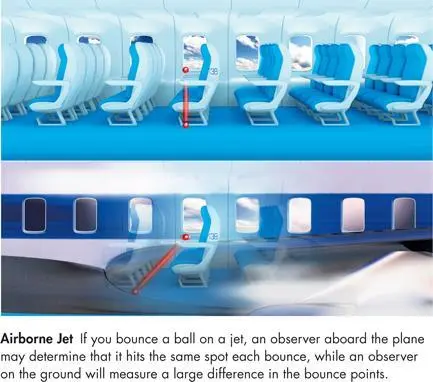
What makes this strange is that, though the two observers measure different times, they are watching the same physical process. Einstein didn’t attempt to construct an artificial explanation for this. He drew the logical, if startling, conclusion that the measurement of the time taken, like the measurement of the distance covered, depends on the observer doing the measuring. That effect is one of the keys to the theory in Einstein’s 1905 paper, which has come to be called special relativity.
We can see how this analysis could apply to timekeeping devices if we consider two observers looking at a clock. Special relativity holds that the clock runs faster according to an observer who is at rest with respect to the clock. To observers who are not at rest with respect to the clock, the clock runs slower. If we liken a light pulse traveling from the tail to the nose of the plane to the tick of a clock, we see that to an observer on the ground the clock runs slower because the light beam has to travel a greater distance in that frame of reference. But the effect does not depend on the mechanism of the clock; it holds for all clocks, even our own biological ones.
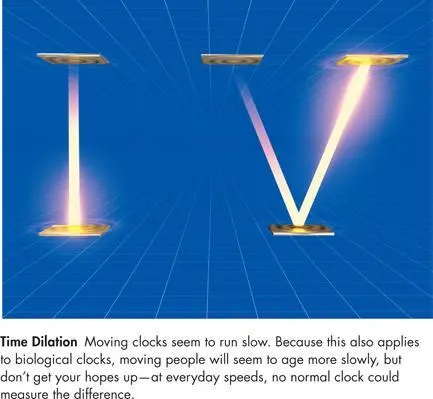
Einstein’s work showed that, like the concept of rest, time cannot be absolute, as Newton thought. In other words, it is not possible to assign to every event a time with which every observer will agree. Instead, all observers have their own measures of time, and the times measured by two observers who are moving relative to each other will not agree. Einstein’s ideas go counter to our intuition because their implications aren’t noticeable at the speeds we normally encounter in everyday life. But they have been repeatedly confirmed by experiment. For example, imagine a reference clock at rest at the center of the earth, another clock on the earth’s surface, and a third clock aboard a plane, flying either with or against the direction of the earth’s rotation. With reference to the clock at the earth’s center, the clock aboard the plane moving eastward-in the direction of the earth’s rotation-is moving faster than the clock on the earth’s surface, and so it should run slower. Similarly, with reference to the clock at the earth’s center, the clock aboard the plane flying westward-against the earth’s rotation-is moving slower than the surface clock, which means that clock should run faster than the clock on the surface. And that is exactly what was observed when, in an experiment performed in October 1971, a very accurate atomic clock was flown around the world. So you could extend your life by constantly flying eastward around the world, though you might get tired of watching all those airline movies. However, the effect is very small, about 180 billionths of a second per circuit (and it is also somewhat lessened by the effects of the difference in gravity, but we need not get into that here).
Читать дальше
